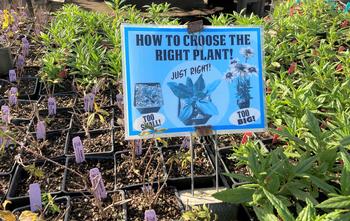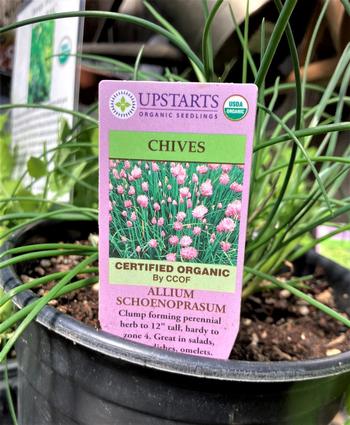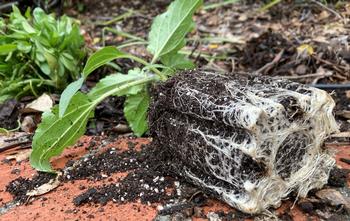Navigating nurseries - 10 tips to avoid buyer’s remorse from a trip to the nursery
-
Alice Cason
-
1. Plan ahead. Before you go to a nursery, decide on your garden needs. Define the scope of your project. Is it a full lawn replacement project, the narrow strip along a sidewalk, or some pots by your main entrance? Look at the site for sun, shade, and fire-smart landscaping requirements.
 Bigger is not necessarily better when choosing the right plants. Photo: Alice Cason
Bigger is not necessarily better when choosing the right plants. Photo: Alice Cason2. Create conditions for plants to survive and thrive over time. Plants from a nursery might need to “harden off” when they arrive home. The transition might require protection from the sun or extra water until they get established. Consider sheet mulching the planting area to suppress weeds, retain moisture and increase organic matter to get ready for new plants.
3. Avoid impulse buys. It is so easy to fall in love with a vibrant blooming plant prominently displayed. A useful design tip is to plant in drifts and swaths rather than buying one of everything. Marin Master Gardeners have lists for Pollinators, Shrubs, Perennials, Trees, and one called Extra Easy for Brown Thumbs: marinmg.ucanr.edu/PLANTS/EXTRA_EASY.
4. Choose plants for Marin County using the California Native Plant Society Garden planner at Calscape: calscape.org. I found 700 plants in my zip code, and 93 are easy to grow. When you grow native plants, you create a habitat for butterflies, birds, and bees. In addition, you support water conservation and can garden without added fertilizers or pesticides.
5. Read the label. Always use the correct botanical name for both genus and species to make sure you get the right plant. The label information can help you determine how big the plant will grow, when it blooms, and what water requirements are. Be sure to read the label. Look for the correct botanical name and organic certification. Photo: Alice Cason
Be sure to read the label. Look for the correct botanical name and organic certification. Photo: Alice Cason6. What is organic? Look for USDA-certified organic labels. The National Organic Program (NOP), which develops regulations for USDA Organic certification, examines agricultural production systems. To become a certified organic producer, farmers develop and implement an "organic system plan." This plan covers a range of practices, such as preserving soil health, crop rotations, pest management, and more. The system is designed to build soil, minimize erosion, and protect the water supply from contaminants.
7. Ask your nursery about Best Management Practices to ensure that plants are not sprayed with pesticides and that sanitary practices to prevent transmission of pathogens like phytophthora are in place. Avoid neonicotinoids. They are systemic and synthetic insecticides used to control insects. That means all insects, including the beneficials like the pollinators you want in your garden. Instead, use Integrated Pest Management and the least toxic ways to control pests.
8. Save money by growing from seeds. You can have many choices, especially for direct sowing food crops. Sowing seeds in place versus transplanting ones started in a greenhouse leads to stress-free growth, especially in plants sensitive to root disturbance, like carrots and radishes. Look for the date on the package to make sure the seeds are fresh.
9. Don‘t be afraid of small plants. A common misconception is that a bigger plant is better. Four-inch and one-gallon plants are the most economical. A 1-gallon plant will often catch up with a five-gallon one if they are planted side by side simultaneously. Avoid root-bound plants with roots growing out of the drainage holes. It can be a sign it has been in a pot too long. Photo: Alice Cason
Avoid root-bound plants with roots growing out of the drainage holes. It can be a sign it has been in a pot too long. Photo: Alice Cason10. Choose a nursery that suits your needs. Marin County has a wide variety of nurseries, from big box stores and large chain nurseries to small independent organic nurseries specializing in native plants. Some nurseries have design services, delivery, and supplies of soil, compost, and fertilizer. Consider whether a helpful staff can help you make the right choices so you can have the right plants in the right place.
For more information, see marinmg.ucanr.edu/PLANTS/HOW_TO_CHOOSE/.



